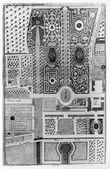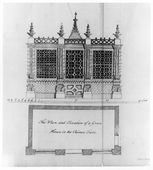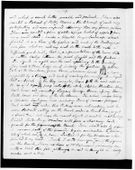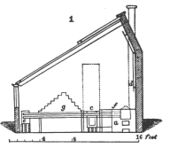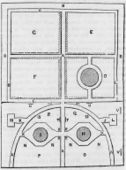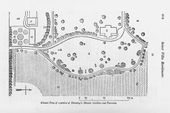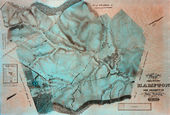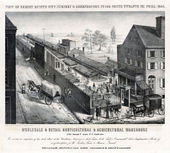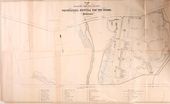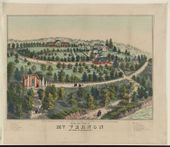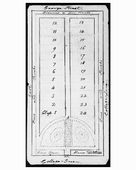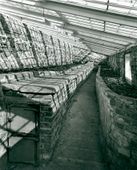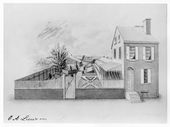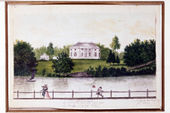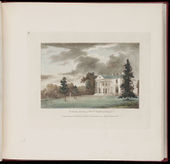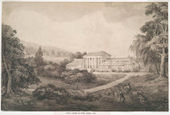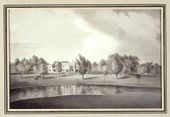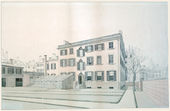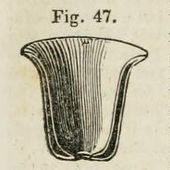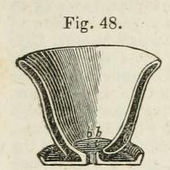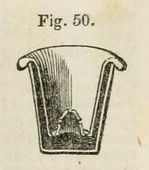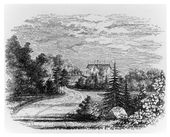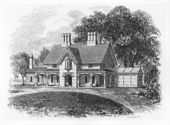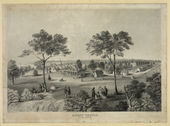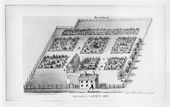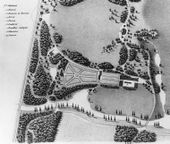Greenhouse
(Green house, Green-house)
See also: Conservatory, Hothouse, Nursery, Orangery
History
The term greenhouse designated a plant-keeping house built to protect tender plants from cold weather. Although these structures were most commonly referred to as greenhouses, the terms “conservatory,” “glasshouse,” and “hothouse” were often used synonymously. Attempts were made to distinguish among the terms. According to Bernard M’Mahon (1806), for example, plants were planted in free soil and in “beds and borders” in a conservatory, whereas in a greenhouse, plants were kept in pots or tubs. A. J. Downing later wrote that plants were kept in the greenhouse until they were ready to be displayed in the conservatory. In actual usage, however, the terms were often used interchangeably. “Hothouse” or “stove” was also used to describe that part of the greenhouse with higher temperatures (see also Conservatory, Hothouse, and Orangery).
Although plant-keeping structures have been built since antiquity, the modern greenhouse, in which light and temperature could be artificially controlled, was possible only after 1700 when glassmaking improved and glass became cheaper [Fig. 1]. In addition to blowing glass, a pouring process was used by manufacturers. The earliest plant houses, which were called greenhouses in this country, had façades with large window openings that were integrated into a masonry, wood, or stone structure [Fig. 2]. These early buildings were replaced by iron-and-glass houses around the turn of the nineteenth century, which revolutionized greenhouse construction by allowing wide-span and filigree structures that let in more light. [1]
Greenhouse construction, evident as early as John Bartram’s 1739 description of Westover, Va., on the James River, continued through the mid-nineteenth century at sites ranging from elite houses such as Mount Clare, Charles and Margaret Tilghman Carroll’s plantation in Baltimore, to the more modest dwelling and greenhouse advertised for sale in Charleston in 1748. The pervasiveness of the structure reflects an interest in keeping exotic plants, which was a fundamental function of a greenhouse. In addition, the greenhouse allowed the extension of the growing season by providing a supportive environment for starting seeds, ripening fruit, and forcing flowers.
Two major concerns in greenhouse design were the admission of light and the creation of artificial heat. These problems could be solved in the modest construction of a building with a high back wall, a low front wall, and a glazed roof above, as shown in the greenhouse at Kirk Boott’s residence in Boston [Fig. 3]. The brick wall of a greenhouse could also serve as support for trellises or espaliered fruit trees. Most simple greenhouses built in this mode did not require the high temperatures or moist atmosphere of hothouses. As M’Mahon pointed out in 1806, such a greenhouse needed only enough artificial heat to “keep off frost and dispel damps,” whereas the hothouse required an inside stove and more glass (see Conservatory and Hothouse for further discussion of heating systems).
Early greenhouses had brick, stone, or dirt floors, but improved designs later made use of wood floors so that the air space under the floor might allow hot air to radiate under the entire floor. [2] A. J. Downing recommended a small, air-tight coal stove and the related Polmaise mode of heating. This heating technique was based on the recirculation of air in the greenhouse: cold air was drawn into a furnace and heated air was expelled into the farthest reaches of the structure. [3] In 1848, Downing described a plant house for Montgomery Place on the Hudson River that utilized this feature.
Texts
Usage
- Bartram, John, July 18, 1739, describing Westover, seat of William Byrd II, on the James River, Va. (1992: 121) [4]
- “Col Byrd is very prodigal in Gates roads walks hedges & seeders [cedars] trimed finely & A little green house with 2 or 3 [orange] trees . . .”
- Smith, John, 1745, describing Springettsbury, near Philadelphia, Pa. (quoted in Weber 1996: 46–47) [5]
- “In the afternoon, the weather being so agreeable, John Armitt and I rode to Charles Jenkin’s ferry on Schuykill. We ran and walked a mile or two on the ice. On our way thither we stopped to view the proprietor’s green-house, which at this season is an agreeable sight; the oranges, lemons and citrons were, some green, some ripe, some in blossom.”
- Anonymous, 1748, describing in the South Carolina Gazette a property for sale in Charleston, S.C. (quoted in Lounsbury 1994: 167) [6]
- “[The dwelling house contains] a large Garden, with two neat Green Houses for sheltering exotic Fruit-Trees, and Grape-Vines.”
- Fisher, Daniel, 1755, describing the greenhouse in the Proprietor’s Garden, Philadelphia, Pa. (quoted in Martin 1991: 211) [7]
- “What to me surpassed every thing of the kind I had seen in America was a pretty bricked Green House, out of which was disposed very properly in the Pleasure Garden, a good many Orange, Lemon and Citrous [sic] Trees, in great profusion loaded with abundance of Fruit and some of each sort seemingly then ripe.”
- Redwood, Abraham, Jr., c. 1760, in a letter to his plantation manager, describing Redwood Farm, seat of Abraham Redwood, Jr., Portsmouth, R.I. (Rhode Island Landscape Survey)
- “I would desire you send to me one hhd of good rum and one hhd of good sugar and I desire that you speak to your overseer to put up in Durt one dozen of Small orange Trees that has bore one or two years with the young fruit upon them, if to be had that has bore two or three years of Saffadella trees, four young figg trees and some Guavas roots, to put in my greenhouse, for I have made a garden of 1 1/2 acres of land and I have built a green house twenty-two feet long, Twelve feet wide and Twelve feet high, and a hotte house Sixteen feet long Twelve feet wide and Twelve feet high, and I have growing in my greenhouse Fifty young fruit trees from six inches to four feet high, and my Gardner says ye largest will not bear fruit these two years, and I have hotte house Strawberries, Bush beans and Crownations in Blossom.”
- Bartram, John, June 24, 1760, in a letter to Peter Collinson, describing his plans for the Bartram Botanic Garden and Nursery, vicinity of Philadelphia, Pa. (quoted in Darlington 1849: 224) [8]
- “Dear friend, I am going to build a greenhouse. Stone is got; and hope as soon as harvest is over to begin to build it, to put some pretty flowering winter shrubs, and plants for winter’s diversion; not to be crowded with orange trees, or those natural to the Torrid Zone, but such as will do, being protected from frost.”
- Anonymous, c. 1765, describing the greenhouse and garden of Dr. Upton Scott, Annapolis, Md. (quoted in Sarudy 1989: 149) [9]
- “He is fond of botany and has a number of rare plants and shrubs in his greenhouse and garden.”
- Ambler, Mary M., 1770, describing Mount Clare, plantation of Charles and Margaret Tilghman Carroll, Baltimore, Md. (1937: 166) [10]
- “took a great deal of Pleasure in looking at the Bowling Green & also at the Garden which is a very large Falling Garden there is a Green House with a good many Orange & Lemon Trees just ready to bear besides which he is now buildg [sic] a Pinery where the Gardr expects to raise about an 100 Pine Apples a Year He expects to Ripen some next Sumer.”
- Washington, George, August 11, 1784, in a letter to Tench Tilghman, describing Mount Vernon, plantation of George Washington, Fairfax County, Va. (quoted in Johnson 1953: 95–96) [11]
- “I shall essay the finishing of my green house this fall, but find that neither myself, nor any person about me is so well skilled in the internal construction as to proceed without a probability at least of running into errors.
- “Shall I for this reason, ask the favor of you to give me a short description of the Green-house at Mrs. Carrolls Mount Clare, plantation of Charles and Margaret Tilghman Carroll, Baltimore, Md.]? I am persuaded, now that I planned mine upon too contracted a scale. My house is (of Brick) 40 feet by 24, in the outer dimensions, and half the width disposed of for two rooms, back of the part designed for the green house; leaving the latter in the clear not more than about 37 by 10.”
- Tilghman, Tench, August 18, 1784, in a letter to George Washington, describing Mount Clare, plantation of Charles and Margaret Tilghman Carroll, Baltimore, Md. (quoted in Trostel 1981: 77) [12]
- “Inclosed you will find answers to your Several Queries respecting the Green House including the order in which they were put, and that you may better understand the Construction of Mrs Carroll’s, I have made a rough Plan of the Manner of conducting the Flues—Your Floor being 40 feet long Mrs Carroll recommends two Flues to run up the Back Wall, because you may then increase the number of Flues which run under the Floor, and which she looks upon as essential—The trees are by that means kept warm at the Roots—She does not seem to think there is any occasion for the Heat to be conveyed all around the Walls by means of small Vacancies left in them She has always found the Flues mark’d in the plan sufficient for her House—
- “She recommends it to you to have the upper parts of your Window sashes to pull down, as well as the lower ones to rise—you then Give Air to the Tops of your Trees—
- “Your Ceiling she thinks ought to be Arched and at least 15 feet high—She has found the lowness of hers which is but 12 very inconvenient—
- “Smooth Stucco she thinks preferable to common Plaster because drier—
- “The Door of the House to be as large as you can conveniently make it—otherwise when the Trees come to any size, the limbs are broken and the Fruit torn off by moving in and out
- “It is the Custom in many Green Houses to set the Boxes upon Benches—But Mrs Carroll says they do better upon the Floor, because they then receive the Heat from the Flues below to more advantage—
- “I recollect nothing more—I hope your Excellency will understand this imperfect description of a matter which I do not know much about myself.”
- Cutler, Rev. Manasseh, July 14, 1787, describing Gray’s Tavern, Philadelphia, Pa. (1888: 1:275) [13]
- “We returned to the grass plat, from which we ascended several glaces by a serpentine gravel walk, and came to the Green-house. It is a very large stone building, three stories in the front and two in the rear. The one-half of the house is divided lengthwise, and the front part is appropriated to a green-house, and has no chamber floors. It is finished in the completest manner for the purpose of arranging trees and plants in the most beautiful order. The windows are enormous. . . .We then took a view of the contents of the greenhouse, beautifully arranged in the open air on the south of the garden. Here were most of the trees and fruits that grow in the hottest climates. Oranges, lemons, etc., in every stage from blossoms to ripe fruit; pine-apples in bloom, and those that were fully ripe. The flowers were numerous and extremely fragrant.”
- Brissot de Warville, J.-P., 1788, describing Mount Vernon, plantation of George Washington, Fairfax County, Va. (1792: 427–28) [14]
- “I hastened to arrive at Mount Vernon. . . . On this rout traverse a considerable wood, and after having passed over two hills, you discover a country house of an elegant and majestic simplicity. It is preceded by grassplats; on one side of the avenue are the stables, on the other a greenhouse, and houses for a number of negro mechanics.”
- Barrell, Joseph, October 19, 1793, in a letter to W. W. Pringle, ordering plants for Pleasant Hill, seat of Joseph Barrell, Charlestown, Mass. (quoted in Hammond 1982: 230) [15]
- “[Ten half standard and ten espaliered Morella cherry trees] to cover the back of my greenhouse. . . . I want a (new) person that understands green house plants & laying out grass plots & grounds, you will send the trees by the same opportunity the gardener comes that he may attend them on the passage.”
- Médéric Louis Élie Moreau de St.-Méry, March 26, 1797 (quoted in Roberts 1947: 240) [16]
- "I went... to visit Robert Morris’s greenhouse [serre chaud] near Philadelphia. It had very beautiful specimens of orange trees, lemon trees, and pineapples.]
- c. September 6, 1797, A Schedule of Property within the State of Pennsylvania Conveyed by Robert Morris, to the Hon. James Biddle, Esq. And Mr. William Bell, in Trust for the use and account of the Pennsylvania Property Company [17]
- "An Estate called the Hills Situate in the Northern Liberties, near the City of Philadelphia, containing Three hundred acres of land highly improved, and on which are erected a large and elegant greenhouse, with a hot house of fifty feet on each side; on the back front a House for a gardener, with one large and five small rooms, also two large rooms on the back or north front of the hot house, with an excellent vault under the green houses, and a covered room for preserving roots & c in winter; the whole being a strong stone building, with the necessary glasses, casements, fruit trees, plants shrubs & c in good order; a well of excellent water, with a pump close to the north front the whole enclosed within a large Garden stocked with fruit trees of the best kind &c. & c."
- Booth, William, 23 September 1799, advertisement in the Federal Gazette and Baltimore Daily Advertiser (quoted in Sarudy 1989: 115) [9]
- “TO BOTANISTS, GARDENERS AND FLORISTS, and to all other gentlemen, curious in ornamental, rare exotic or foreign plants and flowers, cultivated in the greenhouse, hot-house, or stove, and in the open ground. A large and numerous variety of such rarities is now offered for sale. . . .
- “After reserving a general and suitable stock, he has to spare a well assorted and great variety of those things, comprising a beautiful collection, sufficient to decorate, furnish, and ornament a spacious or handsome greenhouse at once. . . . The whole is a truly valuable collection, such as is very rarely to be met with for sale on this side of the Atlantic—indeed a moiety of them would comprise a very desirable and exclusive variety, consisting of many or most of the tropical fruits, and other rare and curious finely ornamental trees, scrubs and plants; with a numerous and abundant assortment of choice bulbous, tubrous, and fibrous rooted flowering and ornamental plants in mixtures . . . for which . . . please apply to John Cummings, at the alms-house, Messrs. David and Cuthbert Landrith, gardeners and nursery-men. . . .
- “N.B. it is now a good time and proper season to build a green-house, and to remove plants.”
- Codman, Dr. John, August 24, 1800, describing the Grange, estate of Dr. John and Sarah Codman, Lincoln, Mass. (quoted in Hammond 1982: 170) [15]
- “behind which are stables (and) servants houses of various kinds, & in particular the gardens and greenhouses all of which are thus covered from sight . . . retirement is the object in this country. To be alone in the world as Adam and Eve were seems to be the taste, and the calm soft sweet scenes to be desirable.”
- Southgate, Eliza, July 6, 1802, describing Elias Hasket Derby Farm, Peabody, Mass. (quoted in Kimball 1940: 76) [18]
- “We returned to the house, which was neat and handsome, and from thence visited the green house, where we saw oranges and lemons in perfection . . . every plant and shrub which was rare and beautiful was collected here.”
- Cutler, Rev. Manasseh, November 22, 1803, describing the Woodlands, seat of William Hamilton, near Philadelphia, Pa. (1888: 2:145) [19]
- “We then took a turn in the gardens and the green-houses. In the gardens, though ornamented with almost all the flowers and vegetables the earth affords, I was not able to walk long. The green-houses, which occupy a prodigious space of ground, I can not pretend to describe. Every part was crowded with trees and plants from the hot climates, and such as I had never seen, all the spices, the tea-plant in full perfection; in short, he assured us there was not a rare plant in Europe, Asia, or Africa, many from China and the islands in the South Seas, none, of which he had obtained any account, which he had not procured.”
Citations
Images
Inscribed
George Washington, Alternate plan (“Plan No. 1”) for the greenhouse at Mount Vernon, n.d.
George Washington, Alternate plan (“Plan No. 2”) for the greenhouse at Mount Vernon, n.d.
Batty Langley, “An Improvement of a beautiful Garden at Twickenham,", in New Principles of Gardening (1728), pl. IX.
Philip Miller, “The Ground Plan of the Green house” and “The Ground Plan of the two Stoves,” in The Gardeners Dictionary ([1754] 1969), p. 577.
William Halfpenny, “The Plan and Elivation of a Green House in the Chinese Taste,” in Rural Architecture in the Chinese Taste (1755), pl. 42.
Samuel Vaughan, Plan of the buildings and grounds of Mount Vernon, 1787.
Andrew Craigie, Proposed Outbuildings for the Craigie Estate, December 11, 1791.
William Dandridge Peck, Plan of the botanic garden of Mr. Curtis, Newbury, Mass., Feb. 19, 1805.
Charles Willson Peale, Letter to Angelica Peale describing his garden at Belfield, November 22, 1815.
J. C. Loudon, Plan, view, and section of green-house, in An Encyclopaedia of Gardening (1826), p. 811, fig. 567.
J. C. Loudon, Greenhouse or conservatory for a flower-garden, with a span roof, in An Encyclopaedia of Gardening (1826), p. 811, fig. 568.
Joshua Barney, Map of the Hampton Estate, 1843.
George William Johnson, Floriculture Building, in A Dictionary of Modern Gardening (1847), p. 230, fig. 51.
Thomas S. Sinclair, "Plan of the Pleasure Grounds and Farm of the Pennsylvania Hospital for the Insane at Philadelphia," in Thomas S. Kirkbride, American Journal of Insanity 4 (April 1848): n.p.
A. J. Downing, Sketch of a “Propagating Pit” (or greenhouse) at Montgomery Place, June 17, 1848.
Anonymous, "Plan of a small Green-House" and "Section of the Same," in A. J. Downing, ed., Horticulturist 3, no. 6 (December 1848): figs. 32 and 33.
Anonymous, “Design for a Country House,” in A. J. Downing, ed., Horticulturist 4, no. 6 (December 1849): pl. opp. p. 249.
Anonymous, "A Country House in the Pointed Style," in A. J. Downing, The Architecture of Country Houses (1850), pl. opp. p. 304, figs. 133 and 134.
Frances Palmer, "Design for a Vinery & Green House," in William H. Ranlett, The Architect (1851), vol. 2, pl. 43.
Frances Palmer, "Cottage Villa in the Anglo Swiss Style," in William H. Ranlett, The Architect (1851), vol. 2, pl. 60, design 52.
Frances Palmer, "Cottage Villa in the earliest English Style," in William H. Ranlett, The Architect (1851), vol. 2, pl. 60, design 53.
- 1123.jpg
1887
Associated
Oscar Alexander Lawson, Robert Buist: Nurseryman & Florist, n.d.
Jeremiah Paul, “Robert Morris’ Seat on Schuylkill,” July 20, 1794.
Samuel McIntire, “South Front of the Green house in the East Building," Elias Hasket Derby House, n.d.
John Archibald Woodside, Lemon Hill, 1807.
William Russell Birch, "Woodlands, the Seat of Mr. Wm. Hamilton, Pennsylva.," 1808, in William Russell Birch and Emily Cooperman, The Country Seats of the United States (2009), p. 69, pl. 14.
Hugh Reinagle, Elgin Garden on Fifth Avenue, c. 1812.
Charles Willson Peale, View of the garden at Belfield, 1816.
Robert Squibb, Green-House: front and back walls, in The Gardener’s Calendar for the States of North Carolina, South Carolina, and Georgia (1827), frontispiece.
William Satchwell Leney, View of the Botanic Garden of the State of New York, 1828.
James E. Teschemacher, "A green-house constructed at the centre of a cottage," in Horticultural Register and Gardener's Magazine vol. 1 (May 1, 1835), opp. p. 157.
John Notman, “No. 1 Ground Plan, Smithsonian Institute,” December 23, 1846.
George William Johnson, Flower Pot, in A Dictionary of Modern Gardening (1847), p. 230, fig. 47.
George William Johnson, Flower Pot, in A Dictionary of Modern Gardening (1847), p. 230, fig. 48.
George William Johnson, Flower Pot, in A Dictionary of Modern Gardening (1847), p. 230, fig. 49.
George William Johnson, Flower Pot, in A Dictionary of Modern Gardening (1847), p. 230, fig. 50.
Anonymous, "Design for a Flower Garden," in A. J. Downing, ed., Horticulturist 2, no. 12 (June 1848): p. 558, fig. 67.
Anonymous, "Cottage Residence of Wm. H. Aspinwall, Esq.," in A. J. Downing, A Treatise on the Theory and Practice of Landscape Gardening (1849), pl. opp. p. 51, fig. 8.
Anonymous, A Country House in the Pointed Style, in A. J. Downing, The Architecture of Country Houses (1850), pl. opp. p. 304, fig. 133.
Anonymous, “Rural Gothic Villa,” in A. J. Downing, The Architecture of Country Houses (1850), pl. opp. p. 322, fig. 148.
Attributed
John Izard Middleton, Greenhouse, 1813.
Nicolino Calyo, Harlem, the Country House of Dr. Edmondson, 1834.
Joseph Jacques Ramée, Estate plan for Calverton [detail], c. 1816, in Parcs & jardins (c. 1836), pl. 1.
Augustus Weidenbach, Belvedere, c. 1858.
- 1460.jpg
1870s
Notes
- ↑ A disadvantage of cast iron technology was that condensation developed as a result of iron’s high thermal conductivity. Humidity control, always a concern, became a real issue in design. Therese O’Malley, Glasshouses: The Architecture of Light and Air (Bronx, N.Y.: The Garden, 2005) view on Zotero
- ↑ Michael F. Trostel, Mount Clare, Being an Account of the Seat Built by Charles Carroll, Barrister, upon His Lands at Patapsco (Baltimore: National Society of the Colonial Dames of America in the State of Maryland, 1981), 120, fn. 2 view on Zotero
- ↑ “Description of the Polmaise Mode of Heating Greenhouses,” Horticulturist 3 (September 1848): 122–27.
- ↑ John Bartram, The Correspondence of John Bartram, 1734-1777, ed. by Edmund Berkeley and Dorothy Smith Berkeley (Gainesville: University Press of Florida, 1992) view on Zotero
- ↑ Carmen Weber, "The Greenhouse Effect: Gender-Related Traditions in Eighteenth-Century Gardening," in Landscape Archaeology: Reading and Interpreting the American Historical Landscape, ed. by Rebecca Yamin and Karen Bescherer Metheny (Knoxville: The University of Tennesee Press, 1996), 32–51 view on Zotero
- ↑ Carl R. Lounsbury, ed., An Illustrated Glossary of Early Southern Architecture and Landscape (New York: Oxford University Press, 1994). View on Zotero
- ↑ Peter Martin, The Pleasure Gardens of Virginia: From Jamestown to Jefferson (Princeton, N.J.: Princeton University Press, 1991). View on Zotero
- ↑ William Darlington, Memorials of John Bartram and Humphry Marshall: With Notices of Their Botanical Contemporaries (Philadelphia: Lindsay & Blakiston, 1849). View on Zotero
- ↑ 9.0 9.1 Barbara Wells Sarudy, "Eighteenth-Century Gardens of the Chesapeake," Journal of Garden History 9, no. 3 (July-September 1989), 104–59. View on Zotero
- ↑ Mary M. Ambler, "Diary of M. Ambler, 1770," Virginia Magazine of History and Biography 45, no. 2 (April 1937), 152–70. View on Zotero
- ↑ Gerald W. Johnson, Mount Vernon: The Story of a Shrine (New York: Random House, 1953). View on Zotero
- ↑ Michael Trostel, Mount Clare, Being an Account of the Seat Built by Charles Carroll, Barrister, upon His Lands at Patapsco (Baltimore: National Society of the Colonial Dames of America in the State of Maryland, 1981). View on Zotero
- ↑ Manasseh Cutler, Life, Journals and Correspondence of Rev. Manasseh Cutler, L.L.D., ed. by William Parker Cutler and Julia Perkin Cutler, 2 vols. (Cincinnati: Robert Clarke & Co., 1888). View on Zotero
- ↑ J.-P. (Jacques-Pierre) Brissot de Warville, New Travels in the United States Performed in 1788 (New York: T. & J. Swords, 1792). View on Zotero
- ↑ 15.0 15.1 Charles Arthur Hammond, "'Where the Arts and the Virtues Unite': Country Life Near Boston, 1637-1864" (unpublished Ph.D. diss., Boston University, 1982). View on Zotero
- ↑ Kenneth Roberts, and Anna M. Roberts, eds., Moreau de St. Méry’s American Journey, [1793-1798] (Garden City, N.Y.: Doubleday, 1947). View on Zotero
- ↑ A Schedule of Property within the State of Pennsylvania Conveyed by Robert Morris, to the Hon. James Biddle, Esq. And Mr. William Bell, in Trust for the use and account of the Pennsylvania Property Company, c. September 6, 1797, Autograph Collection of the Historical Society of Pennsylvania, original MS reproduced Robbins, 1987, 136. View on Zotero
- ↑ Fiske Kimball, Mr. Samuel McIntire, Carver, the Architect of Salem (Portland, Maine: Southworth-Anthoensen, 1940). View on Zotero
- ↑ Masnasseh Cutler, Life, Journals and Correspondence of Rev. Manasseh Cutler, L.L.D., ed. by William Parker Cutler and Julia Perkin Cutler, 2 vols. (Cincinnati: Robert Clarke & Co, 1888). View on Zotero



